Environment News
Data on lead in Donkey Creek slows to a trickle
Donkey Creek is an unprepossessing-looking stream, but glamour isn’t everything.
The small salmon-bearing creek is well-known and well-liked by locals and visitors. The waterway takes an annual star turn when fish fans venture to its banks for the Donkey Creek Chum Festival, a celebration of the salmons’ return to the stream where they were born, to spawn and die.
Many locals may not know that Donkey Creek — and North Creek, a prime stream originating just uphill — figure prominently in 20-year-long efforts to measure and mitigate lead poisoning of threatened habitats for salmon, the Pacific Northwest’s totemic fish.
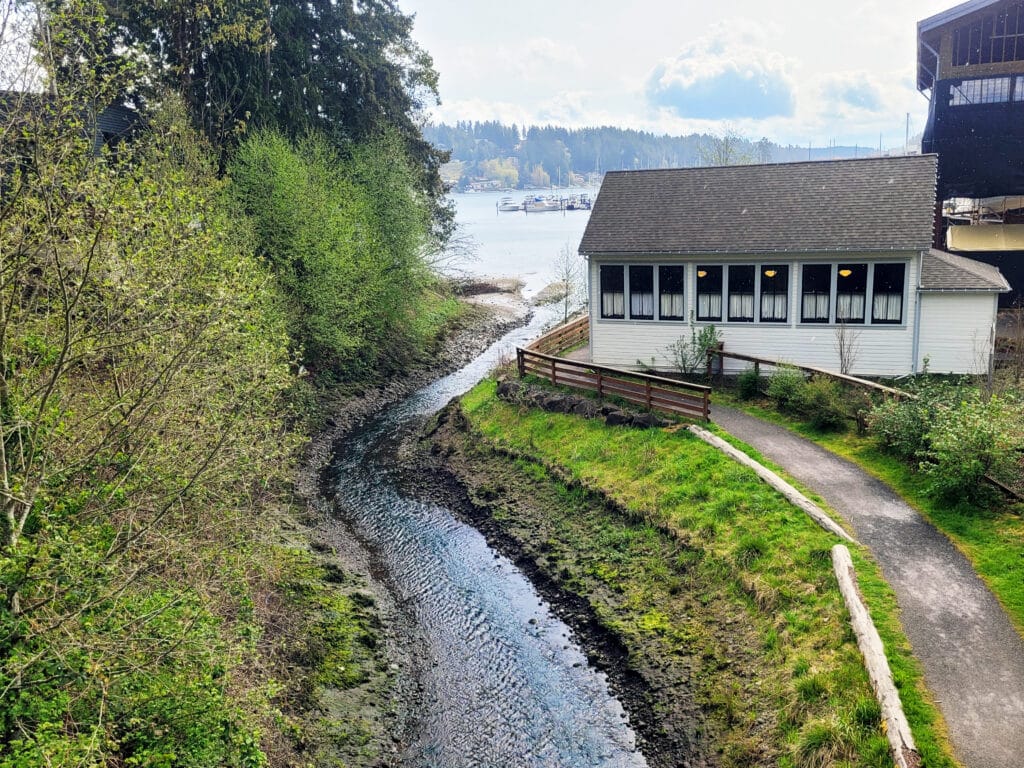
Donkey Creek empties into Gig Harbor near the Harbor History Museum.
Major delays in conducting definitive tests of creek water could ultimately checkmate expansive and expensive plans to restore salmon-bearing streams such as Donkey Creek and North Creek.
Lead in Donkey Creek
The Tacoma-Pierce County Health Department found alarmingly high levels of toxic lead in both Donkey Creek and North Creek in 2002. That 2002 study was amplified in 2008 creek water tests by the Washington state Department of Ecology that showed the lead problem persisting.
Dissolved lead levels in the creeks were a stunning 900 times higher than normal. ‘‘This,’’ Ecology’s report concluded, “is the highest lead concentration found in Washington State surface waters.’’
As Gig Harbor Now reported earlier this year, Ecology traced the major source of lead to the Gig Harbor Sportsman’s Club shooting range, located upstream from Donkey Creek. A tributary of North Creek runs through the shooting range, where lead ammunition is used.
In October 2015, the Sportsman’s Club and the state’s Toxics Clean-Up Program agreed to review and finalize a clean-up plan for the polluted creek water. Ecology officials have since stated that the Sportsman’s Club carried out mitigation measures that the state required to that point.
That should have settled it, but it hasn’t. A severe staff shortage at Ecology has stalled review and implementation of the 2015 plan for nearly seven years. Are Donkey Creek and its immediate surroundings clean, or are they still absorbing lead?
Fish and Wildlife flexes its mussels
A second state agency may have an answer to that question.
Recent research on mussels by the Washington Department of Fish and Wildlife, conducted where Donkey Creek meets txʷaalqəł Estuary, suggests that toxic lead pollution may well be ongoing. These WDFW tests conducted in Gig Harbor waters have not been previously reported.
“We have a mussel-monitoring location on the Donkey Creek delta, and have at least two years of data in mussels transplanted there,’’ says Jim West, chief research scientist at Fish and Wildlife’s Marine Resources Division. “Lead in the caged mussels we deployed there for three-month periods in 2020 and 2018 exhibited relatively high levels of lead. Of 86 and 74 cages of mussels distributed throughout the Sound in 2020 and 2018, Donkey Creek exhibited the eighth-highest lead concentrations.’’
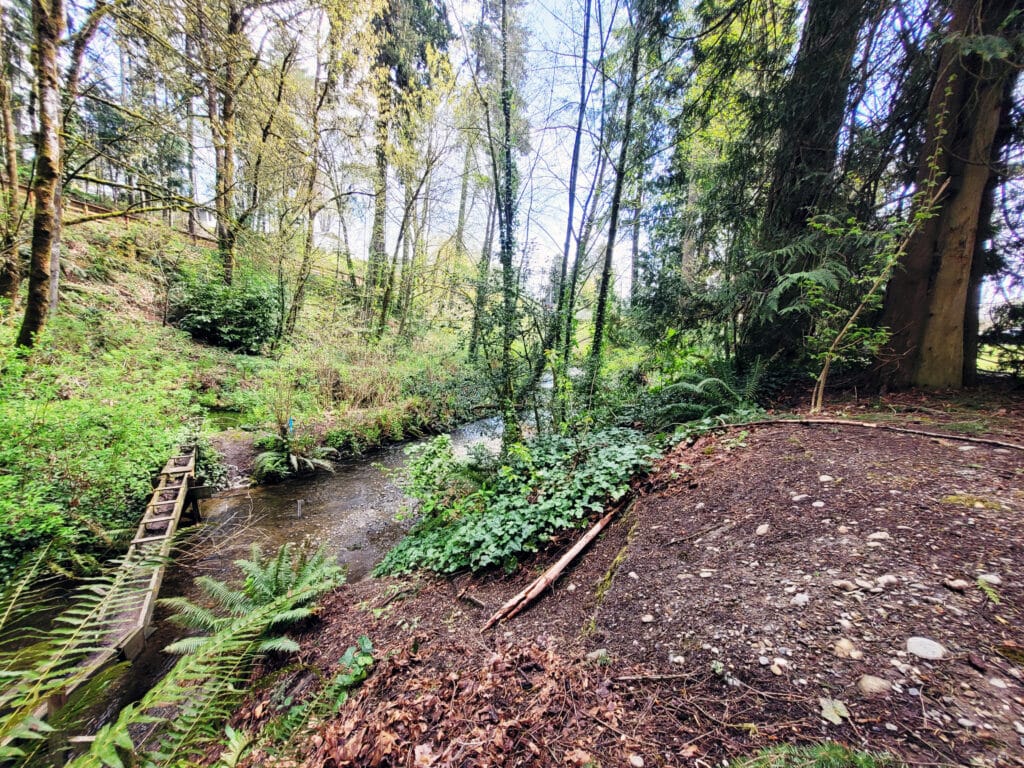
Donkey Creek as it runs through the city park named after it. A 20-year-old study showed alarmingly high levels of toxic lead in the stream, but few tests have been performed on it since.
What about more recent years? That should soon be clarified. Preliminary data from a 2021-22 survey of mussels in the Donkey Creek delta should be available this summer, according to Mariko Langness, lead biologist for the WDFW’s 13-year-old Mussel Watch program.
The briny bivalves are not raised for food, but are used as tools to measure toxins in nearshore water. Mussels filter various chemicals but don’t metabolize them. Fish and Wildlife’s laboratory in Olympia examines tissue from the exposed mussels and records toxicity levels.
‘Raise a red flag’
Referring to the seven-year drought in lead testing of Gig Harbor creek water, Fish and Wildlife’s Jim West said in an email to this writer, “Thank you for bringing this to our attention. Although our monitoring is associated with no regulatory authority, we raise a red flag for Ecology … when situations like this arise.’’
Given that Fish and Wildlife’s Gig Harbor results seem to have largely flown under the radar, the Washington State Department of Ecology may indeed need a heads up.
Ecology maintains there’s little it can do in the near-term to jump-start renewed lead testing in Donkey Creek proper.
“Due to staff vacancies from a large number of retirements – and difficulty filling those vacancies – Ecology’s Toxic Cleanup Program has been unable to reassign the management of this site,” said Dave Bennett, communications manager of Ecology’s Solid Waste Management Program. “We are working to fill vacant positions as soon as possible and have a goal to reassign this site later this year.’’
A draft remedial investigation, he adds, was done in 2020 to augment the 2015 deal, but it was not acted upon given that it’s still a draft.
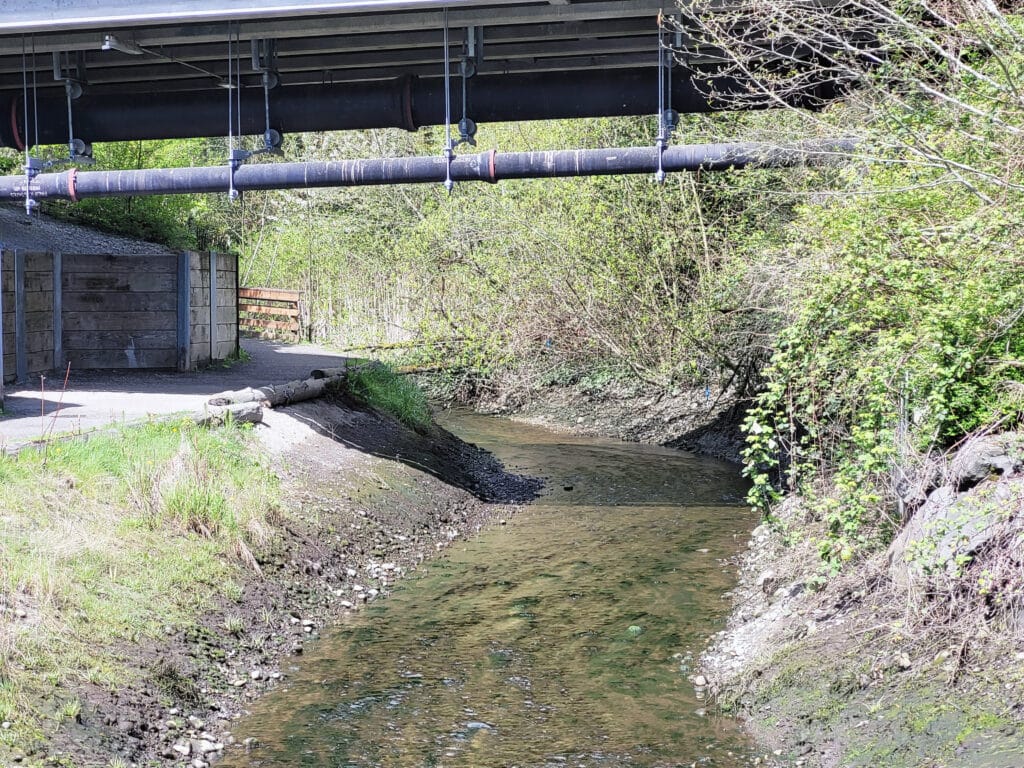
Years of work to restore Donkey Creek
This is broadly characteristic of the glacially slow progress in Gig Harbor’s decade-long quest to transform Donkey Creek into a robust, pollution-free, free-running salmon stream.
In 2012, for example, the city hired Nakano Associates, a Seattle landscape architecture and urban design firm, to lead a Donkey Creek daylighting and estuary restoration project.
“The project removed a 350-foot-long culvert and replaced it with a section of road with a bridge,’’ according to Nakano Associates’ website. “Creek and estuary improvements included stabilizing the stream bank against future erosion and improving the stream as a spawning habitat for chum salmon.’’
The project also included the public walking path along the stream and beneath the 80-foot bridge that connects Donkey Creek Park with the Harbor History Museum and Austin Estuary Park. Native Northwest trees and shrubs were planted alongside the creek.
Gig Harbor’s salmon-bearing Crescent Creek has also had partial removal of fish-blocking culverts. According to Lucinda Wingard, a member of the nonprofit Crescent Creek Alliance, the three-mile-long creek has generally tested “as one of the cleanest on the peninsula.’’ Crescent Creek, located at the northwest end of Gig Harbor, doesn’t meet or mingle waters with Donkey Creek.
Storm water runoff and pollutants
According to media accounts going back a full decade, the city of Gig Harbor has directed at least $5 million of city, state and federal money for upgrading Donkey Creek. It expects to spend millions more.
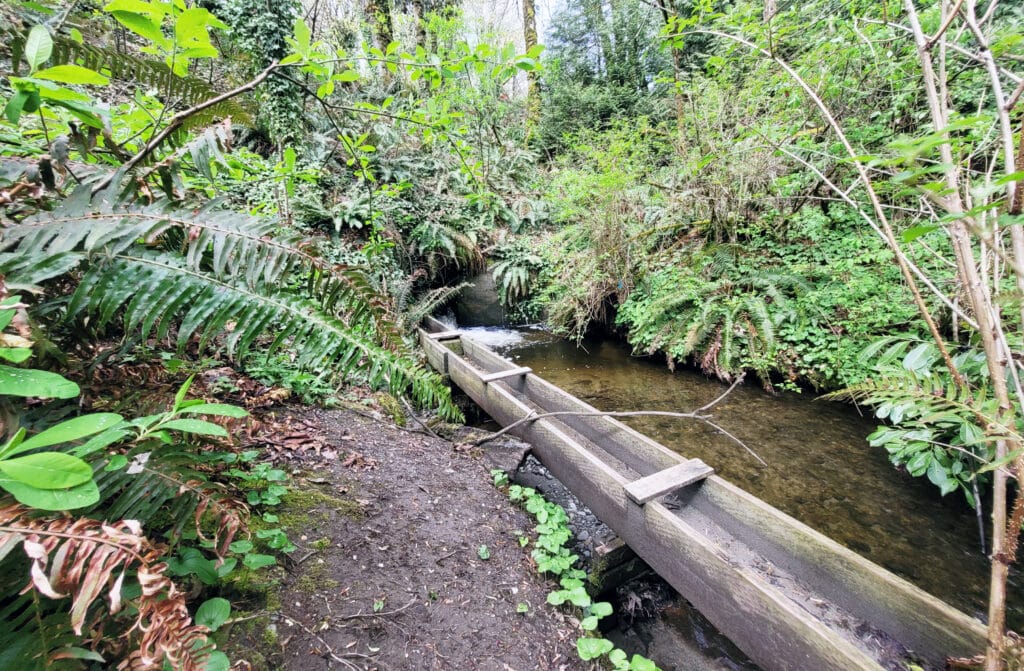
Donkey Creek near the culvert that carries water under Harborview Drive.
Despite estimable past efforts and ambitious future plans, there is scant indication those plans include testing for lead — and, if necessary, an actionable plan for removing it.
Much attention is understandably given to contaminants — motor oil, soil, pesticides — that run off, untreated, during storm water surges.
Lead contamination, by contrast, seems to be the unseen elephant in the room.
Various kinds of pollution are associated with storm water runoff. Brienn Ellis, the city’s engineering technician for storm water, acknowledges the problem: “Storm water pollution is considered the largest water pollution problem in urban areas of Washington state. The more hard surfaces, the more storm water runoff, which can carry pollutants into our waterways.’’
Moreover, “storm water runoff will probably always have an effect on salmon health,’’ she allows.
Culverts and North Creek
That said, the city centers its efforts to improve salmon habitat by removing culverts and other obstacles to fish passage. Culvert removal isn’t a legal requirement on local streams, she attests, but adds that the city recognizes the benefits of culvert removal.

Donkey Creek near the culvert that carries water under Harborview Drive.
“Starting by the end of 2022,’’ she says, ‘’the city is preparing to remove another culvert along North Creek where the creek crosses Burnham Drive. Lastly, the city is preparing to complete a feasibility study by the end of 2022 to study the removal of another culvert along North Creek at Harborview Drive.’’
Asked about testing creek water pollution, Ellis points to the Pierce Conservation District Stream Team, whose volunteers monitoring North Creek, but acknowledges that “it does not include testing for lead.’’
Gig Harbor Planning Director Jeff Langhelm has spoken broadly of salmon restoration in media accounts. In December, Langhelm estimated that removing the city’s culverts and other fish obstacles could ultimately cost up to $100 million over several decades.
‘Canaries in the coal mine’
Despite seeming local inattention to lead, the wide-ranging environmental degradation of Puget Sound, where Donkey Creek’s waters eventually end up, commands regional attention.
City Council member Roger Henderson underscored this at a City Council meeting on March 14.
“It’s important for the people of Gig Harbor to maintain the storm run-off systems and we’ve got some excellent people working on that, to keep as much (run-off) as we can out of Puget Sound,’’ Henderson said. He also stressed the necessity of “continuing to conserve land for our riparian corridors in critical (areas), and removing fish barriers to improve our salmon stock.’’
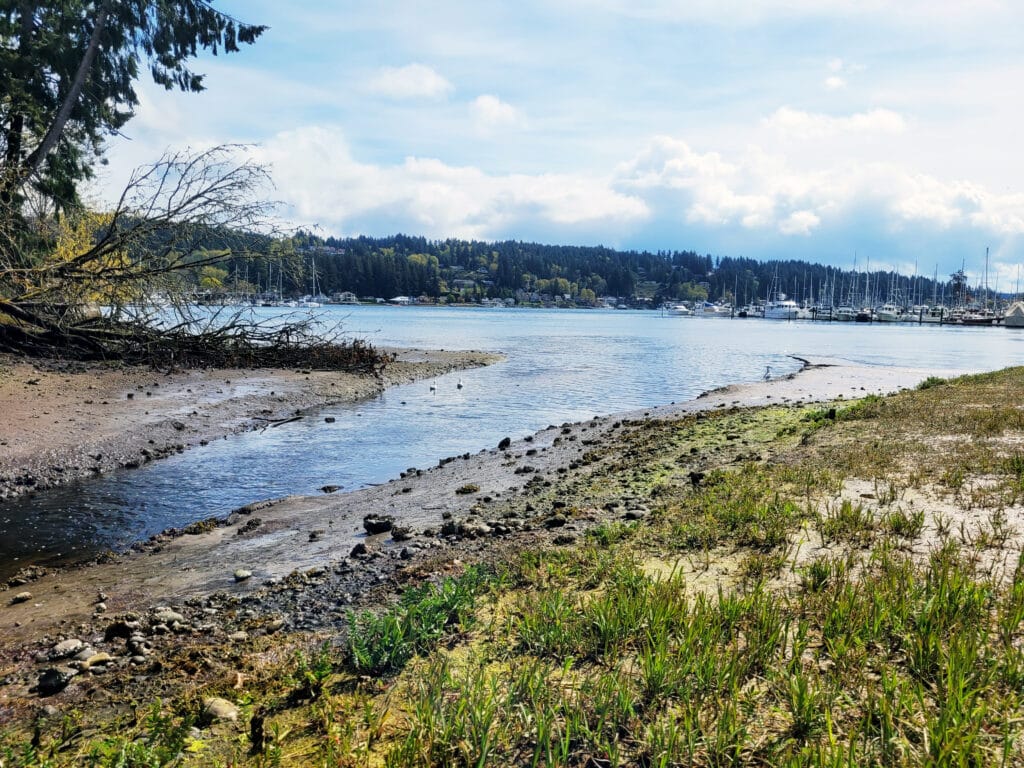
Donkey Creek at the Austin Estuary, where it empties into Gig Harbor.
At the March council meeting, Henderson, the City Council’s liaison to the West Sound Partnership for Environmental Restoration, shared a video that included observations from regional environmental leaders. One of them, Cecilia Gobin, a conservation policy analyst for the Northwest Indian Fisheries Commission, said of Puget Sound:
“When you look at its surface, it looks OK. There’s the water. The tides are still changing. There’s still people out there fishing. But underneath, and when you look at the salmon and killer whales, for example, those are the canaries in the coal mine that tell us a much different story.’’
Preserving habitat
As this precis shows, the city has worked long and hard to restore salmon habitat and ensure a clean environment. Such projects continue.
The Gig Harbor Land Conservation Fund, a nonprofit founded in January and chaired by City Council member Robyn Denson, secured $50,000 in pledges and grants to help preserve a 5.15 acre site in one of three North Creek Salmon Heritage sites. According to the Fund’s website, all three of the contiguous wooded parcels provide habitats for chum and coho salmon, as well as Puget Sound steelhead trout and coastal cutthroat trout.
The city intends to buy all three parcels and has signed purchase sale agreements with the owners, according to Parks Manager Matthew Keough. The mayor, city administrator and city attorney negotiate terms with the owners, who Keough describes as willing sellers.
“We’re very pleased about it,’’ he says.
The three parcels combined have an assessed value of $2,263,000, but the sale prices are likely to differ. A variety of sources, including the city, fund the purchase of these urban wooded areas so near to sensitive salmon habitats. Keough also gives props to the Pierce County Conservation Futures Fund for helping to turbo-charge the purchases.
The aforementioned Donkey Creek Chum Festival, canceled last year due to the pandemic, may make a comeback this year if the virus cooperates – and the $5,000 budget for the popular event comes together for the festival’s co-sponsors, the Harbor History Museum and Harbor WildWatch.
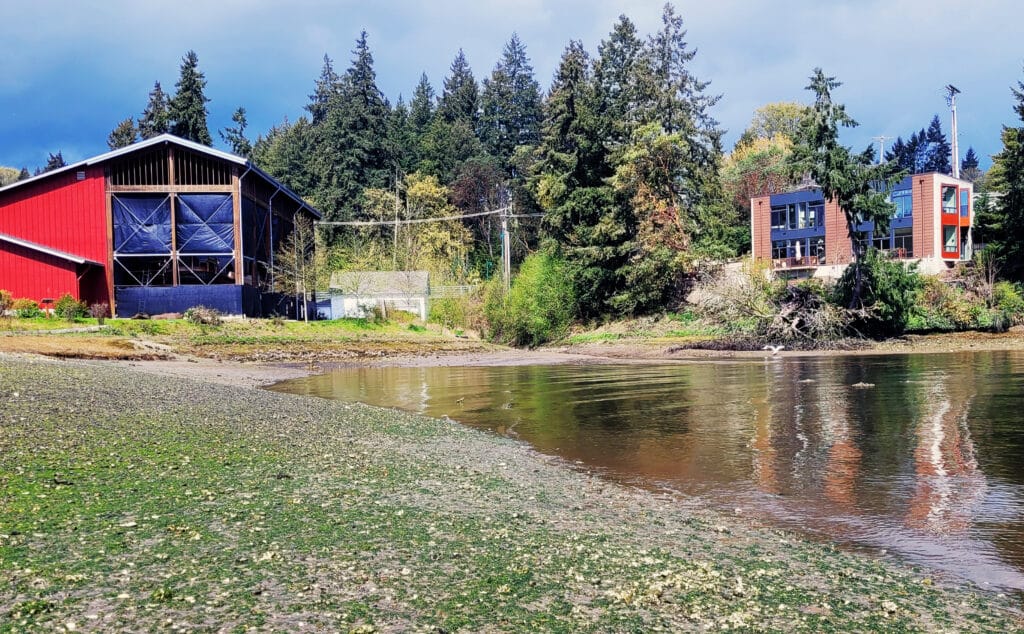
Donkey Creek flows into Gig Harbor near the Harbor History Museum.
Harbor WildWatch executive director Lindsey Stover said the organization obtained a $2,500 grant through the city’s Lodging Tax Advisory Committee, but still needs another $2,500 to stage the festival. “Unfortunately, that means we won’t be announcing a date for the 2022 Chum Festival until those funds are secured,” Stover said.
A lead elephant in the room
Now, let’s run the numbers for this slow-motion salmon saga:
One public festival. One county health department. Two state environmental departments. A long-term expenditure that could hit $100 million. Multiple decades in which to spend the money. A 20-year wait for lead pollution data to catalyze needed remedial action.
All this is testimony to the hard work of so many to benefit a beloved and important fish.
And still, the toxicity elephant remains in the room, hidden in plain sight.
